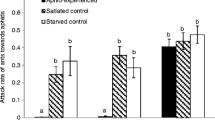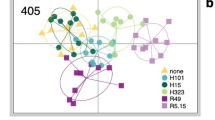Abstract
The aphidiid waspLysiphlebus cardui parasitizes in ant-attendedAphis fabae cirsiiacanthoidis colonies without causing aggressive behavior in the antLasius niger. By contrast,Trioxys angelicae, another aphidiid parasitoid of aphids, is rapidly recognized and vigorously attacked by the ants.L. niger workers also responded differently to dead individuals ofL. cardui andT. angelicae. DeadL. cardui parasitoids were often ignored when encountered byL. niger, whereas deadT. angelicae individuals were immediately grasped by ants that discovered them. However, hexane-washed parasitoids caused a similar reaction pattern in the ants, in that both aphidiid species were tolerated in the aphid colony. Lure experiments demonstrated that chemical stimuli on the cuticle are major cues for the ants to distinguish between the parasitoids. The hexane extract ofL. cardui transferred to washed individuals ofT. angelicae resulted in ant responses characteristic towardsL. cardui, andL. niger workers displayed the typical removal pattern they normally showed towardsT. angelicae whenT. angelicae extract was applied toL. cardui individuals. Both parasitoid species treated with the hexane extract ofA. fabae cirsiiacanthoidis were similarily treated by the ants as were aphid control individuals. The suggestion that the aphidiid waspL. cardui uses chemical mimicry is discussed.
Similar content being viewed by others
References
Banks, C.J. 1962. Effect of the ant,Lasius niger, on insects preying on small populations ofAphis fabae Scop, on bean plants.Ann. Appl. Biol. 50:669–679
Eisner, T., Hicks, K., Eisner, M., andRobson, D.S. 1978. “Wolf-in-sheep's-clothing” strategy of a predaceous insect larvae.Science 199:790–794
El-Ziady, S. 1960. Further effects ofLasius niger onAphis fabae Scop.Proc. R. Entomol. Soc. London A 35:30–38
El-Ziady, S., andKennedy, J.S. 1956. Beneficial effects of the common garden ant,Lasius niger L., on the black bean aphid,Aphis fabae Scopoli.Proc. R. Entomol. Soc. London A 31:61–65
Flanders, S.E. 1951. The role of the ant in the biological control of homopterous insects.Can. Entomol. 83:93–98
Gilby, A.R. 1980. Chemical methods (lipids), pp. 217–252,in T.A. Miller (ed.. Cuticle Techniques in Arthropods. Springer-Verlag, New York.
Hölldobler, B., andWilson, E.O. 1990. The Ants. Springer-Verlag, Berlin.
Howard, R.W., McDaniel, C.A., andBlomquist, G.J. 1980. Chemical mimicry as an integrating mechanism: Cuticular hydrocarbons of a termitophile and its host.Science 210:431–433
Howard, R.W., Mcdaniel, C.A., andBlomquist, G.J. 1982. Chemical mimicry as an integrating mechanism for three termitophiles associated withReticulitermes virginicus (Banks).Psyche 89:157–167
Howard, R.W., Stanley-Samuelson, D.W., andAkre, R.D. 1990a. Biosynthesis and chemical mimicry of cuticular hydrocarbons from an obligate predator,Microdon albicomatus Novak (Diptera: Syrphidae) and its ant prey,Myrmica incompleta Provancher (Hymenoptera: Formicidae).J. Kans. Entomol. Soc. 63:437–443
Howard, R.W., Akre, R.D., andGarnett, W.B. 1990b. Chemical mimicry of an obligate predator of carpenter ants (Hymenoptera: Formicidae).Ann. Entomol. Soc. Am. 83:607–616
Jackson, L.L., andBlomquist, G.J. 1976. Insect waxes, pp. 201–233,in P.E. Kolattukudy (ed.. Chemistry and Biochemistry of Natural Waxes. Elsevier, Amsterdam.
Kistner, D.H. 1966. A revision of the African species of the Aleocharine tribe Dorylomimini (Coleoptera: Staphylinidae). II. The generaDorylomimus, Dorylonannus, Dorylogaster, Dorylobactrus, andMimanomma, with notes on their behavior.Ann. Entomol. Soc. Am. 59:320–340
Kistner, D.H. 1979. Social and evolutionary significance of social insect symbionts, pp. 340–413,in H.R. Herrmann (ed.. Social Insects, Vol. I. Academic Press, New York.
Lockey, K.H. 1988. Lipids of the insect cuticle: origin, composition and function.Comp. Biochem. Physiol. 896:595–645
Maneval, H. 1940. Observations sur un Aphidiidae (Hym.) myrmécophile. Description du genre et de l'espèce.Bull. Soc. Linn. Lyon 9:9–14
Mason, R.T., Fales, H.M., Eisner, M., andEisner, T. 1991. Wax of a whitefly and its utilization by a chrysopid larva.Naturwissenschaften 78:28–30
Moritz, R.F.A., Kirchner, W.H., andCrewe, R.M. 1991. Chemical camouflage of the death's head hawkmoth (Acherontia atropos L.) in honeybee colonies.Naturwissenschaften 78:179–182
Nault, L.R., Montgomery, M.E., andBowers, W.S. 1976. Ant-aphid association:Role of aphid alarm pheromones.Science 192:1349–1351
Pontin, A.J. 1959. Some records of predators and parasites adapted to attack aphids attended by ants.Entomol. Mon. Mag. 95:154–155
Sokal, R.R., andRohlf, F.J. 1981. Biometry, 2nd ed. Freeman, San Francisco.
Takada, H., andHashimoto, Y. 1985. Association of the aphid parasitoidsAclitus sappaphis andParalipsis eikoae (Hymenoptera, Aphidiidae) with the aphid-attending antsPheidole fervida andLasius niger (Hymenoptera, Formicidae).Kontyu, Tokyo 53:150–160
Vander Meer, R.K., andWojcik, D.P. 1982. Chemical mimicry in the myrmecophilous beetleMyrmecaphodius excavaticollis.Science 218:806–808
Vander Meer, R.K., Jouvenaz, D.P., andWojcik, D.P. 1989. Chemical mimicry in a parasitoid (Hymenoptera: Eucharitidae) of fire ants (Hymenoptera: Formicidae).J. Chem. Ecol. 15:2247–2261
Völkl, W. 1992. Aphids or their parasitoids: Who actually benefits from ant attendance?J. Anim. Ecol. 61:273–281
Völkl, W., andMackauer, M. 1993. Interactions between ants attendingAphis fabae ssp.cirsiiacanthoidis on thistles and foraging parasitoid wasps.J. Insect Behav. 6:301–312
Way, M.J. 1963. Mutualism between ants and honeydew-producing Homoptera.Annu. Rev. Entomol. 8:307–344
Author information
Authors and Affiliations
Rights and permissions
About this article
Cite this article
Liepert, C., Dettner, K. Recognition of aphid parasitoids by honeydew-collecting ants: The role of cuticular lipids in a chemical mimicry system. J Chem Ecol 19, 2143–2153 (1993). https://doi.org/10.1007/BF00979653
Received:
Accepted:
Issue Date:
DOI: https://doi.org/10.1007/BF00979653




